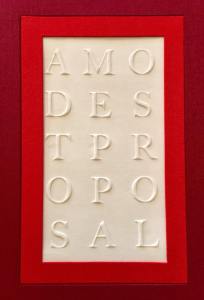
We are extremely pleased to announce that Ximena Pérez Grobet’s artist book, Reading Finnegans Wake, is on its way to the Thomas Fisher Rare Book Library at the University of Toronto. It will become part of the DeLury Irish Literature collection (which has upwards of 300 Joyce works, including approximately 30 copies of Finnegans Wake) and the Marshall McLuhan Library (which has several copies of Finnegans Wake, heavily annotated by McLuhan – he claimed to have “cracked the code” behind the book). It is, arguably, the perfect home for the work.
Ximena‘s interpretation and reconstruction of James Joyce‘s masterpiece, Finnegans Wake, is one of the most extraordinary examples of an artist book we’ve had the pleasure of representing. Ximena had the Faber & Faber original disbound, had the textblock cut into strips, maintaining the original order, line by line and page by page, and then spent several years *knitting* the textblock back together. It is a work of mad genius, and the result is a visual and tactile gem.
I actually began working with Ximena and her Nowhereman Press because of this book, first working with some of her other books while she was finishing this masterwork…all the while, hoping she would allow me to represent it. Several years ago, I had stopped by her booth at CODEX – my attention caught, in large part, by the fact that she was sitting behind her table casually knitting strips of paper together on a pair of needles. The idea enchanted me, in no small part as I could hear my Belfast-born, Joyce-lover grandfather laugh and say, “Well, it’s no more nor less comprehensible than the original.” It was another year or so before she finished it, and the result is simply brilliant. Bound into four volumes, matching the four books of the work, it is a clever, elegant, and lovely artistic interpretation of the work.
“Finnegans Wake is a novel by James Joyce, written in 1939. It is considered one of the most complex books in English literature, as well as being unique in its experimental writing style. The purpose of the work is to visually display this complexity. Using a classic 1965 edition by Faber & Faber, the book was disbound, woven and rebound, respecting the original order of the pages and preserving the same cover. The new edition consists of 4 volumes covering the four parts and 450 pages of the original edition.” [Artist Statement]





























































































 The/rapist is an investigation into the gendered history of psychosurgery, as illustrated by the career of Doctor Walter Freeman (1895-1972). A Professor of Neurology with no formal training in either surgery or psychology, Freeman popularized the pre-frontal lobotomy, an operation in which nerve connections to and from the frontal lobes—the seat of human emotion, creativity, willpower, and imagination—are severed. A self-styled showman who drove ice picks through his patients’ eye sockets, rode around in a “lobotomobile,” and conducted a 1953 tour dubbed “Operation Ice-Pick,” Freeman freely admitted that his work created a “surgically induced childhood,” with many “failed outcomes.”
The/rapist is an investigation into the gendered history of psychosurgery, as illustrated by the career of Doctor Walter Freeman (1895-1972). A Professor of Neurology with no formal training in either surgery or psychology, Freeman popularized the pre-frontal lobotomy, an operation in which nerve connections to and from the frontal lobes—the seat of human emotion, creativity, willpower, and imagination—are severed. A self-styled showman who drove ice picks through his patients’ eye sockets, rode around in a “lobotomobile,” and conducted a 1953 tour dubbed “Operation Ice-Pick,” Freeman freely admitted that his work created a “surgically induced childhood,” with many “failed outcomes.”




































